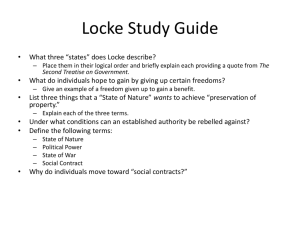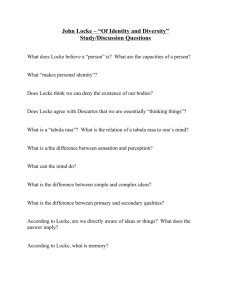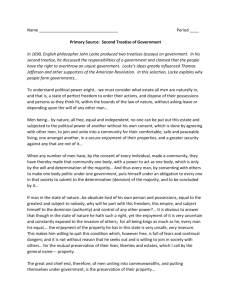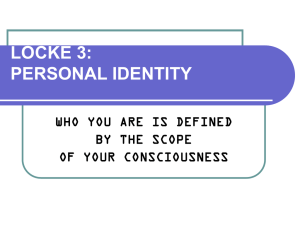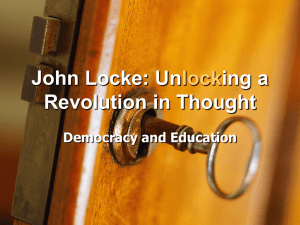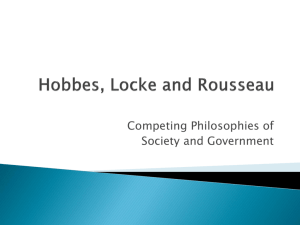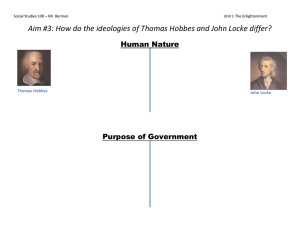Philosophy 224
advertisement
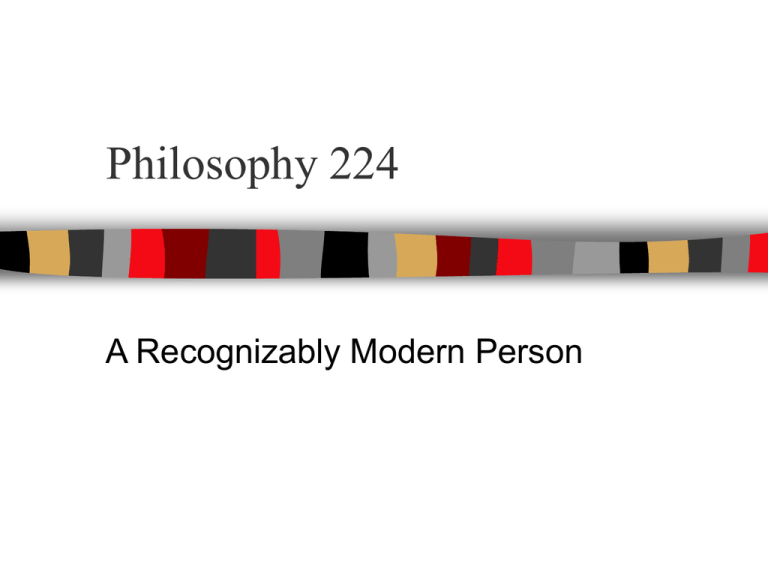
Philosophy 224 A Recognizably Modern Person René Descartes Descartes was born in 1591 in La Haye, France. He died in 1650 in Sweden. Educated by the Jesuits, he was dissatisfied with the products of what was at the time the best education possible. The problem as he saw it was the sterility and conflict of scholastic (church) philosophy, which was incapable of fending off skepticism. He set himself the task of providing an indubitable foundation for human knowledge The foundation he found: Cogito, ergo sum. Modern Philosophy Descartes is the first philosopher of what is called Modern Philosophy. Though in actuality it is the philosophy of the 17th and 18th centuries, the era is called “Modern” because it marks the end of philosophy dominated by the church and by its concerns, and by the introduction of a number of themes still operative today. These themes include: the struggle against skepticism, the dominance of science and mechanism over spiritualism, and a focus on and confidence in subjectivity. Treatise On Man The Treatise on Man is a conceptual exercise. Descartes sets out to shed some light on our natures by describing a creature like a human being that God could create. As he makes explicit, the point of the effort is to clarify his dualistic conception of the human being (mind/body dualism) and to discuss how two radically distinct natures could nonetheless be “joined and united” in a way consistent with our self-experience. In actuality, he doesn’t do all of this, focusing in the Treatise, and in our section, on a mechanical account of the body. Our Bodies, Our Machines Descartes mind/body dualism supposed an absolute distinction between body stuff and mind stuff. In his more technical philosophical works, Descartes speaks of two substantial orders: Res Cogitans (thinking stuff) and Res Extensa (extended/material stuff). Here, he speaks of the soul and a “machine made of earth’ (68c1). The key feature of this account of the body is that it is a machine. That means that every function of the body can be explained by mechanical interaction. An Example of Mechanism: Sensation The thoroughgoing mechanistic nature of Descartes’ account of the body is easily seen in his treatment of sensation. The sense organs contain “tiny fibers” which are stimulated by the objects of sense. The action of these fibers in turn pull on parts of the brain, which open the brain to the influence of the objects of sense, ultimately producing in the mind the sensed object. Cf. 69c2-70. The Pineal What? One of the most surprising features of Descartes' account is his attempt to link the mechanical properties of the body to the rational faculties of the mind or soul. He speculate early in the Treatise about a rarefaction, by contraction, of the blood, eventually transforming a purely material stuff into “a certain very fine wind” the “animal spirits” (68c2) which, in the pineal gland (itself a mixture of the two substances) enables the transition between mind stuff and body stuff. A Modern Philosopher Though there is much to be critical of in Descartes account of mind/body dualism, it is clearly an account which abandons much of the Greek (and thus Christian) conception of the soul. “In order to explain these functions, then, it is not necessary to conceive of this machine as having any vegetative or sensitive soul…apart from its blood and its spirits which are agitated by the heat of the fire burning in its heart—a fire which has the same nature as all the fires that occur in inanimate bodies” (74c2). John Locke Locke was born in 1632 in England and died in 1704. His life encompassed momentous times in English history including the Civil War, the formation of the Commonwealth and the restoration. For most of these events, Locke was a mere observer, hidden away at Oxford. Eventually, under the patronage of the Earl of Shaftesbury, Locke emerged into public life and became a very important intellectual figure, the founder of British Empiricism and a prominent poltical theorist. The Essay and Personal Identity Locke’s An Essay Concerning Human Understanding was his most significant philosophical contribution. In it he sets out a very influential system of philosophical empiricism based on a theory of ideas which accounts for them in terms of generalization from sense experience. For us, its most profound contribution comes in the form of an account of personal identity. Persons and Identity Locke starts, reasonably enough, with a definition of ‘person:’ “…a thinking intelligent being, that has reason and reflection and can consider itself as itself…which it does only by…[self] consciousness” (82c1). Self-consciousness is important here because Locke insists that perception of any kind requires the recognition that one is perceiving (apperception). Thus, consciousness is key to Locke’s account of personal identity, which he defines initially as “the sameness of a rational being” (Ibid). The Poison and The Cure Locke makes the advantages and disadvantages of linking personal identity to consciousness immediately clear. Self-consciousness has built into it an element of persistence of and to self across diverse moments and experiences. At the same time, however, consciousness seems inevitably to admit of gaps (forgetfulness, unconsciousness) that serve as the moment of a question: am I the same self? The Real Confusion For Locke, this is more of an apparent problem than a real one. It arises in significant part because of our mistaken temptation to link personal identity to persistence of material substance. That this is mistaken Locke makes clear by reflection on our relationship to our bodies. While our sense of our identity is often tied up in our bodies, no one of us would insist that if we lost a limb, the severed part was identical to us. It would just be a piece of flesh. The Confusion Explained Returning to consciousness we can now understand the puzzle posed by those gaps. The temptation is to think of them like our severed hand. However, Locke points out, we know of them as gaps, because they are gaps between moments of consciousness, and consciousness of them as gaps is the basis for recognition that it is one and the same person conscious before and after. A couple of implications A couple of interesting points follow from Locke’s account of persona identity in terms of the continuity of consciousness. First, if we could somehow translate consciousness from one body to another, we would presumably produce one and the same person (85c2). Second, if one and the same body completely looses its conscious integrity, it becomes a different person (86c1-2). The Payoff: An Account of Moral and Legal Responsibility One of the most important benefits of Locke’s account is its ability to underwrite a theory of responsibility. If we are going to hold someone responsible, we have to be sure that we have the right someone. The advantage of identifying person with consciousness is that we are able to assert continuity of the person over time, and thus hold people responsible for past acts (86c1).
